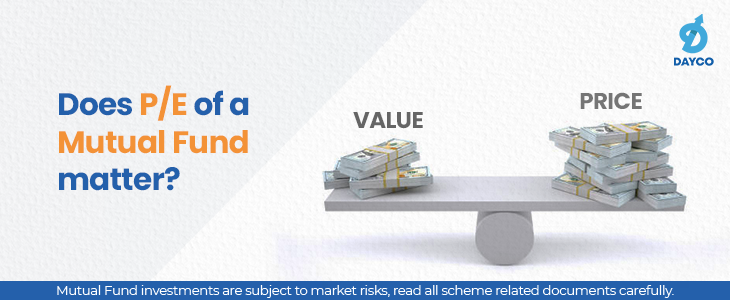For your direct equity investments, the Price-to-Earnings (P/E) ratio stands as a beacon, guiding you through the tricky waters of stock valuation. It helps you understand what other investors are willing to pay for one rupee of company’s earnings This simple metric can help you understand the expectation from a stock in the market and whether the stock is expensive or cheap. Yet, when it comes to equity mutual funds, should you give P/E the same importance and care or does it need a more nuanced evaluation, one that is different from the conventional wisdom surrounding individual stock valuation?
The P/E Ratio
At its core, the P/E ratio captures the price investors are willing to pay for receiving one rupee of a company’s earnings. P/E essentially mirrors the relation between investor sentiment and corporate profitability. A higher P/E ratio often signifies heightened investor expectations. It can be indicative of higher anticipated earnings growth or simply irrational exuberance. Conversely, a lower ratio may denote subdued growth prospects or a cheap stock, aligning with the domain of value investing.
P/E and Equity Mutual Funds
Unlike individual stocks, where the P/E ratio offers a glimpse into the company’s growth trajectory, for funds, it is more complicated than that.
For equity funds, the P/E ratio is calculated based on weighted average of the P/Es of all constituent stocks. A funds P/E will change over time similar to an individual stock. The fund’s P/E in itself may not offer much insight but when used in comparison to the benchmark or the category it can offer insight into the investment orientation of the fund. If a fund’s P/E is lower than its benchmark or most of the fund’s in the similar category, you can come to a conclusion that the fund follows a value style of investing and has a value bias. Similarly, a fund with high P/E when compared with peer funds and the benchmark may be a fund that follows the growth style of investing. Remember that these conclusions don’t mean that one fund is better than the other and may perform better in the future. It just tells you if the portfolio has more growth stocks or more value stocks. It will only help you understand the investment orientation of the fund. Also, cash in the portfolio and loss-making companies do not have a P/E, hence a fund’s P/E may be automatically lower if it has a high concentration of any of these.
While the P/E ratio serves as a barometer of a fund’s investment orientation, its standalone significance is less in comparison to other critical factors that should be used while evaluating a fund. Factors such as your risk appetite, investment horizon, performance consistency of an equity fund, risk management of the fund, fees, and the experience of the fund management team is more crucial than a singular metric like P/E. For return analysis of a fund, you can check the CAGR of the fund over the last 10 years and for better analysis of return consistency, use rolling returns. These figures should be compared with the benchmark of the fund and the category of the mutual fund. Rolling return is a way of measuring a fund’s return over a particular time period for a fixed rolling period. The rolling frequency can be monthly, daily, weekly, etc. For example, if you want the three-year rolling return of a fund over the last 10 years standing on 30th November 2022 on a monthly roll frequency, you would start from 30th November 2012. The first period will be from 30th Nov 2012- 30th Nov 2015, then 31st Dec 2012- 31st Dec 2015, and so on. The average rolling returns arrived will give you a more accurate picture for than point-to-point returns (CAGR).
Risk analysis involves checking crucial metrics like standard deviation, Beta, Sharpe, Sortino, and Alpha to check how the fund is managing risk. Again, these ratios should be compared with the peer funds and the scheme’s benchmark (Sharpe, Sortino, and Standard Deviation) for better understanding of risk. You should also compare the TER (Total Expense Ratio – the fee charged to you for managing your funds) among peer funds to choose a fund with a reasonable fund management charges.
A holistic approach, integrating these diverse elements, should be your path in informed decision-making and selecting good equity funds.
Conclusion
As you navigate direct stock investments, the Price-to-Earnings ratio stands as a compass among other things, guiding your journey through the vastness of the equity market. However, when it comes to mutual funds, P/E is not very relevant. By embracing a holistic analysis, one that includes analysis of the fund’s return consistency, risk management, fund management team, fee, risk appetite, and investment horizon, you can chart a course towards effective wealth creation in the ever-evolving landscape of mutual funds.
If you have a question, share it in the comments below or DM us or call us – +91 9051052222. We’ll be happy to answer it.
~ Nischay Avichal
















